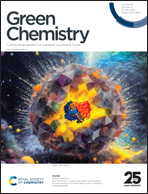Green and sustainable in situ water treatment: a review of noble-free catalysts for electrochemical oxygen reduction to hydrogen peroxide
Abstract
Water treatment is an essential process for ensuring access to clean and safe drinking water. Activation of hydrogen peroxide (H2O2) to ·OH is considered to be one of the most potential methods for treating micropollutants in water. However, traditional methods of producing H2O2 for water treatment involve the use of expensive and hazardous chemicals, which can compromise the safety and sustainability of this process. In contrast, the electrochemical oxygen reduction reaction (ORR) method offers a greener and more cost-effective approach to producing H2O2 for water treatment. In our proposed review, we will focus on the use of noble-free catalysts for electrochemical oxygen reduction to H2O2 in in-situ water treatment. We provide an in-depth analysis of the theoretical foundations of the 2e- ORR process. We also classify the types of noble-free catalysts and summarize their applications in water treatment and environmental remediation. Additionally, we highlight the challenges and opportunities associated with this promising new approach, including scalability, stability, and selectivity of the catalysts. Our review offers valuable insights for both researchers and practitioners in this important field, and we are confident that it will stimulate new research and innovation in the development of greener and more sustainable water treatment methods.
- This article is part of the themed collection: 2024 Green Chemistry Reviews

 Please wait while we load your content...
Please wait while we load your content...